A 3D micromechanical model for hyperelastic rubber-like materials and its numerical resolution by the Asymptotic Numerical Method (ANM)
IF 4.4
2区 工程技术
Q1 MECHANICS
引用次数: 0
Abstract
In this work, a micromechanical model is developed to describe the behavior of macromolecular chains and to reflect the hyperelastic behavior of rubber-like materials. This model generalizes the model recently developed in Ouardi (2023). The behavior law is defined by the minimization of a potential energy, each macromolecular chain has been represented by elastic segments linked by nonlinear elastic spiral nodes. We thus obtain a model with only three characteristic parameters. We investigate, in the case, the effect of the number of macro-chain segments and the shape of the Representative Volume Element (RVE) using a high-order algorithm of the family of the Asymptotic Numerical Method (ANM) (Cochelin, 2007). In the ANM algorithm, the solution of the nonlinear problem is sought branch by branch, each branch being represented by a Taylor series. In this way, this high-order algorithm makes it easier to continuously investigate the solution curves. Numerical simulations are presented on different RVEs, four and eight chains models (Arruda and Boyce, 1993), under three types of boundary conditions: uniaxial tension, pure shear and equibiaxial tension. These numerical simulations are compared with experimental data from Treloar (1944) to identify the parameters material and to demonstrate the robustness of the proposed model. The studied chains models show a slight influence of the number of macro-chains and the number of segments in the RVE.
求助全文
约1分钟内获得全文
求助全文
来源期刊
CiteScore
7.00
自引率
7.30%
发文量
275
审稿时长
48 days
期刊介绍:
The European Journal of Mechanics endash; A/Solids continues to publish articles in English in all areas of Solid Mechanics from the physical and mathematical basis to materials engineering, technological applications and methods of modern computational mechanics, both pure and applied research.

 求助内容:
求助内容: 应助结果提醒方式:
应助结果提醒方式:


